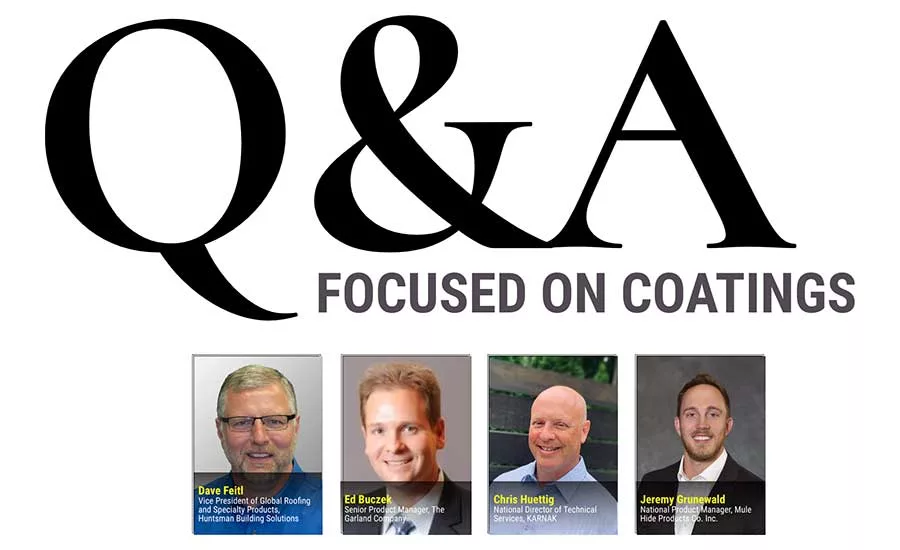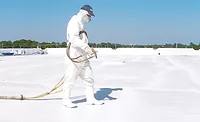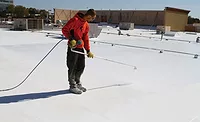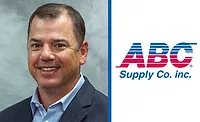Industry Q&A: Focused on Coatings

The use of coatings in roofing has been on the upswing for the past few years, and may have hit its stride in 2022. While the economy is certainly strained by the COVID-19 pandemic and record inflation that ensued, demand is strong. Significant weather events — whether along the traditionally targeted coastlines, or highly-active plains — show no signs of weakening. So it may not be a surprise to see optimism in the marketplace, given that during challenging economic times, facility owners will often pass on complete reroof projects and rely on coatings instead to extend a roof's lifespan. But there’s more to it now.
Cost pressures and a desire from facility owners to be more aware of their environmental footprint, and even set sustainability goals, have pushed more opportunity into the market. We ask leading industry experts to give us a sense of what’s happening to the coatings industry, and what roofing contractors can expect in the near future. Here’s what we learned:
RC: How would you describe the state of the roof coatings market today?
Dave Feitl, vice president of global roofing and specialty products, Huntsman Building Solutions (DF): The roof coatings market is experiencing increasing demand, in part due to the performance of the products and in part due to current economic conditions. Roof coatings have always been an integral part of our business. We’re seeing an uptick in the use of both acrylic and silicone roof coatings among our contractor customer base. We believe a variety of factors are driving that increase, including the state of the economy, the price of energy, and the fact that the cooling and reflective properties of roof coatings enable radiant heat to be reflected off the roof, reducing the structure’s energy consumption overall. It’s a perfect set of circumstances for rising demand in roof coatings.
Chris Huettig, national director of technical services, KARNAK (CH): The roof coatings market has never been as robust in its history as what we are experiencing today. Manufacturers have access to more advanced raw materials, allowing them to make better performing products to meet the demands of the industry. With the supply shortages our industry has seen over the last couple of years, demand for coatings from contractors has increased as they evaluated other ways to provide roof solutions to clients. Sustainable initiatives have also continued to promote repair and maintenance to reduce unnecessary waste streams going to our landfills.
Ed Buczek, senior product manager, The Garland Company (EB): Roof coatings experienced significant growth due to several factors, such as advancements in roof coating technology, ease and speed of installation, roof insulation/fastener shortages delaying reroof construction and building owners understanding the value of fluid-applied roof restoration systems. Many roofing contractors are now better equipped and trained to install restoration coatings properly for long-lasting performance and have found it valuable to augment their overall roofing platform. The roof coating market is expected to rise as the winds of an expected recession threaten plans for larger capital roofing projects.
Jeremy Grunewald, national product manager, Mule-Hide Products Co. Inc. (JG): Sales of coatings are growing significantly faster than that of other roofing products. Building owners are looking to extend the lives of their existing roofs and delay the expense and disruption of replacement. They also are embracing the energy efficiency and other environmental benefits that coatings offer. And, with current supply chain challenges, coatings have been more readily available than some other products, helping keep projects on schedule. Acquisition activity has been substantial, with several sizeable deals taking place over the past 18 months. Larger manufacturers are purchasing smaller to medium-sized companies to expand their product offerings, particularly in silicone products.
RC: What was the biggest impact of the supply shortage on your company, and are you still feeling it today?
DF: The biggest impact of the supply shortage to us was access to enough raw materials. At times, we would have a full supply of one material but a shortage of another. Today, in part because of better planning around current shipping and supply challenges, we have all the raw materials and ample supply.
CH: No sector of the industry was completely shielded from supply shortages. Like many, we faced shortages of particular raw materials, but fortunately for us, the variety of polymer technologies we offer allowed us to offer alternative coating technologies to our contractors to fulfill their customers' needs.
The greatest impact the supply shortage had on our company is the impact it had on both contractors and building owners/managers. Roofing contractors that wouldn’t consider coatings solutions in the past decided to give them a try. The supply shortage also allowed building owners who needed their building investment protected to test roof coating systems as a solution to restore rather than replace their roofs. This resulted in a new pool of coatings believers that will continue to use our products long after roofing supplies come back to normal.
EB: While we weren’t immune to supply issues, our domestic manufacturing and the extra efforts of our team members helped us to continue servicing our customers. From a positive perspective, the biggest impact of the supply chain for Garland was that it has enabled greater creativity across our organization — we approach every challenge with an orientation toward “what can we do?”
JG: Every manufacturer is still working through some of the fallout from supply chain issues. However, the challenges are becoming fewer and farther between. We still have some products that experience longer lead times than others, but the overall outlook is positive.
RC: Were there any lessons learned as a company? As an industry?
DF: The past two years demonstrated an industry-wide need to plan for unforeseen circumstances and events. Huntsman Building Solutions has diversified our raw materials and keeps a three- to six-month supply of all materials on-hand at all times. To handle this expanded supply, we have created larger storage capacity, which will allow us to weather a shortage, shipping delay or a natural disaster that may occur in the future.
CH: Many valuable lessons were gained or reinforced. These included maintaining close relationships with raw material suppliers and having qualified secondary supply sources to hedge against shortages. Inventory management and cost accounting governance also remain crucial during times of supply uncertainty. With regard to discussing roof coating restorations, we need to set honest expectations for the customer so informed decisions can be made.
EB: We have learned that we are a resilient company and so is the industry. Strong relationships with vendors, suppliers, contractors and customers are critical and pay dividends in such a time as this. The industry will be stronger as a result, as they have pulled together to get better and maintained service to customers in these times of uncertainty.
JG: Manufacturers, distributors, and contractors have had to develop creative ways to serve their customers. Ultimately, these challenges made the industry better because it forced us all to think outside the box. A great example in the fluid-applied space was approaching projects in phases. Instead of completing all phases of a coating project in one block of time, the contractor does the detail work (seams, fasteners, penetrations, etc.) first, and then comes back later when product is available to complete the project. This is just one example of the creative solutions that were used to keep the industry moving forward in the face of shortages.
RC: How is the company better positioned to move forward from this?
CH: The best relationships are forged during difficult times. We believe our company’s behavior during this difficult time demonstrated our dedication to servicing our customers with great service and consistent high-quality products they can trust. Change makes us all stronger and better equipped to move our industry forward. We have a renewed focus on offering a broad range of tested product solutions that solve our customer’s needs. This will continue to raise the bar for the coatings industry.
DF: Huntsman Building Solutions is well positioned as we are able to manufacture our materials in multiple locations. Multiple manufacturing locations give us an upper hand in dealing with a major disaster or weather event, so that we are always able to meet contractor requirements.
JG: We certainly learned not to take things for granted. No manufacturer can prepare for the kind of supply chain shortages that the pandemic produced. However, we did learn to look at our vendor partnerships and products in a more creative light. Going forward, we are better positioned to provide solutions when faced with challenges. We’ve also invested considerable time, focus and energy in the coatings side of our business to position Mule-Hide at the forefront of the fluid-applied space. We’ve expanded our product offering; added coatings experts to our team; enhanced the education opportunities for our technical and sales teams, distributor partners and contractors; and added to our library of training materials.
RC: Are there still misconceptions about coatings and adhesives in the roofing market today?
DF: I think the technologies have advanced to the point they are very robust. We are able to offer 20-year warranties with our coatings products. What we are also realizing is that some adhesives are replacing mechanical fasteners, which eliminates the need to put holes into roofs. You can now glue board stock and the roof deck. This is a quicker application and recent wind uplift tests show the failure point well surpasses what it would be with mechanical fasteners.
CH: We believe most misconceptions about roof coatings from the past have been dispelled. Today’s roof coating products offer a variety of options and solutions and are superior in quality and performance than those of the past. The key to overcoming any remaining concerns is through education and training. Helping contractors gain the necessary knowledge to achieve successful roof coating restoration is a critical part of raising the bar for our industry. The National Roofing Contractors Association (NRCA) has several training modules to help, and we are doing our part with our Qualified Applicator Program and KARNAK University.
EB: Absolutely, I believe there are misconceptions about roof coatings on both sides of the spectrum. Some are of the understanding that roof coatings are nothing more than “painting” the roof and do not offer much long-term value, while others feel they could be used to save any existing roof system despite the condition of the roof. Neither are correct. Fluid-applied roof systems of the right technology to fit the aged roof system can perform for many years providing the installation was done well. On the other hand, if the existing roof is not qualified to receive a fluid-applied restorative solution or past its “window of restoration,” then another solution such as roof replacement is required.
JG: Coatings are often thought of as “miracles in a bucket” that will fix any roofing problem on any roof. They are not. They can restore still-sound roofs to near-new condition, extending their lifespans, sprucing up their appearance and potentially enhancing their energy efficiency. They will not magically breathe new life into a roofing system that is unsound or has unsolved underlying issues. When a coating doesn’t perform as expected, the cause is almost never the product itself. It is virtually always because the coating was applied in an environment it was not designed to be in. The solution is education and manufacturers supporting their contractors.
RC: What is the message to contractors not in the coatings market?
DF: Contractors not currently active in the sector should know that coatings are a way to round out your portfolio. This is a rapidly growing market that could likely double over the next five years. Contractors not in coatings are missing a huge opportunity to service the retrofit and reroof market specifically.
CH: For those contractors not in the coatings market, you are missing an opportunity to diversify and shield your business from economic downturns. Coatings play a key role in building a strong maintenance and repair department. Not only do they offer a steady revenue stream, but qualifying roofs for coating also provides new opportunities for reroofing those that are not candidates. Both phases of the business benefit from one another, making the business more resistant to economic swings.
EB: There’s an excellent opportunity to provide customers with additional roof asset management solutions that can extend the service life of existing roof systems. Fluid-applied roof restoration offers building owners significant cost savings compared to other alternatives and provides contractors with an additional revenue stream. This diversification also helps the contractor stay active in times of economic uncertainty when customers may not be willing to invest in roof replacement projects. Proper existing roof diagnosis and qualification is essential to determine if the existing roof is a restoration candidate.
JG: For a residential roofing contractor that wants to expand into the commercial space, coatings offer the lowest barrier to entry. They provide a great way for a contractor to learn how to inspect/evaluate commercial buildings, work with professionals in the commercial real estate industry, and execute projects that must consider elements such as client workflow, parking, safety, etc. that are specific to commercial properties. There is little investment in tools and equipment required. A project can be completed and billed quickly. Manufacturers will provide training and support to help ensure that a potential project is an appropriate candidate for coating, help choose the right coating for that roof, and make sure that the crew knows how to correctly apply the coating to meet warranty specifications.
It is imperative that contractors understand that coatings are not new roofing systems. They are restoration products designed to add service life to an existing roofing system. They should not be presented on the same level as a new roofing system.
RC: Are you feeling the pressures of finding safer or more environmentally-friendly solutions to current product lines?
DF: The suite of Huntsman Building Solutions building envelope, roofing and coatings solutions are all designed for sustainability, energy efficiency, resiliency and low Earth impacts. Additionally, our coatings solutions are very low VOC. Rather than feel pressure, we view demand for environmentally-friendly building solutions as a huge opportunity for us, as they are a cornerstone of our business.
CH: The pressure starts from within with our own goals to offer more environmentally-friendly product solutions. KARNAK has been a leader in reflective technologies that save energy, lower VOC coatings, and NSF-rated products to protect our water resources. We believe it is smart to promote and build on the sustainable benefits roof coatings continue to offer. Testing the products to standards that validate these environmental benefits is critical in helping contractors and building owners make better-informed decisions.
EB: Rather than sideline environmentally-friendly solutions as an alternative to current product lines, Garland’s product development strategy puts sustainability at the core, meaning we look holistically for sustainable innovation within all of our products and product families. Sometimes that is a seemingly minor change like shifting packaging of sealants to sausage tubes to use more product and reduce waste that goes to landfill. It may also be thinking about a product’s formulation. Above all, we’re thinking about how we can help asset owners achieve their sustainability goals with roofing systems that help reduce energy consumption.
JG: Mule-Hide Products is among the industry leaders when it comes to offering products that increase buildings’ energy efficiency and reduce waste from roof tear-offs. We continue to look for opportunities to introduce new fluid-applied products that will deliver value to customers and significantly improve the roofing industry’s environmental impact.
RC: How are you contributing to the sustainability/resiliency conversation in roofing?
DF: Most of the applications of our coating products are in reroof projects, as a means to coat and repair an existing roof membrane. In these applications, the existing roof doesn’t need to be torn off and thus roofing debris is not going into landfills. Contractors power wash, prep the roof and re-coat, and a 20-year warranty is provided. With the resulting reduction in heat load to the building, significant energy is saved. This ultimately means that the structure is more sustainable, energy efficient and contributing less to climate change.
CH: Coatings offer solutions to repair, seal and extend the service life of qualified existing roofs, which reduces unnecessary waste to landfills and extends the service life of functioning construction materials already in use in the field. Highly-reflective roof coatings improve energy efficiency of existing and new roofs. The ability to maintain and restore roofs are the key advantages coatings offer towards sustainability. We continue our investment to develop high-performance, environmentally-friendly products that extend the life of the roof and offer fire resistance while improving energy efficiency and water run-off quality.
EB: Garland contributes to the sustainability conversation by actively engaging all the constituencies involved in the building envelope — the architect, the building owner, and of course, the roofing contractor. When the manufacturer is involved in the sustainability conversation at every level of a project — from design, to installation, to maintenance — everyone’s needs can be met with the best possible solution, and collaboration can find opportunities that might be missed otherwise. Ultimately, we believe the most sustainable roof is one that lasts, and together with our contractor partners, that’s a message we’ve been advancing since the 1990s.
JG: Sustainability and environmental resiliency are among our biggest priorities across all of our product areas, and coatings provide one of the greatest opportunities on that front. Coatings allow you to restore an existing roof and extend its life, reducing the amount of roofing material that ends up in landfills. They also can make a building more energy efficient, helping reduce the amount of energy needed for cooling and helping mitigate the urban heat island effect.
We work closely with others in the roofing industry to support research, product testing, and educating contractors about the benefits of roof coatings and how to properly apply them. We are actively involved in such organizations as the Roof Coatings Manufacturers Association, the Cool Roof Ratings Council, the NRCA and local roofing contractors associations.
RC: What are your biggest concerns looking ahead?
DF: Our biggest concern at Huntsman Building Solutions is the professional development of contractors. There is an ongoing shortage of labor compounded by the older generation cycling out into retirement. It’s important that we provide education and training to the younger generation coming into the field so that market needs are met. We founded HBS University, a robust online training provider, to address these concerns with quality education. We provide monthly online courses for contractors across a variety of subjects relative to product installation. Contractors who complete the courses not only grow their industry skillset but can become an authorized HBS contractor, signaling their professionalism and ability to install our products with care, ensuring optimum performance.
CH: One of our biggest concerns is for coatings to be used on roofs that are not candidates for coating. Moisture surveys should be done on all roofs, except metal, to aid in qualifying whether a roof can be coated or not. Coatings applied to roofs that are wet internally leave contractors and building owners with ill feelings. Not every roof is a candidate for coating. As proud coating manufacturers, we educate and work with our contractor partners to help them evaluate roof candidates for coating. Second, is proper training. We continue to provide free education and training to help them succeed with roof coating application.
EB: From a global perspective, continued supply shortages, rising inflation and energy costs and a looming recession will continue to be impactful in the days ahead. In the roof coating industry, it’s imperative that manufacturers continue to train and support contractors with solid product education and application training. This support is critical to the successful performance of roof coating systems and confidence that customers require to embrace these solutions.
JG: The outlook for coatings is overwhelmingly positive. The sky is the limit. There will continue to be a bit of volatility in supply and pricing, thanks to ongoing supply chain challenges and general economic uncertainty, but it’s hard to point to an area of big concern.
As an industry, we need to maintain our focus, momentum and energy to make coatings the forefront of roof restoration. We’ve made great progress in recent years, but there’s a lot more ground to cover. Continued outreach to contractors, and providing contractors with ongoing education and training, are key.
If there’s an Achilles heel in fluid-applied roofing, it’s a lack of education and training and manufacturers investing in contractors’ success. That leads to poor installations, which gives coatings a black eye. We can make the industry better by developing strong customer relationships and helping our products succeed by helping our contractors succeed.
RC: What are you proudest of about your organization as we close 2022?
JG: To invest in the coatings segment is to invest in smaller businesses. You’re giving small and mid-size contractors another avenue to do good work and make money. I’m proud of how, by devoting time, energy, focus and resources to the fluid-applied arena, we’re helping those contractors succeed.
Also, the roofing industry has faced a lot of adversity this year. Our team has done a phenomenal job of overcoming those challenges and continuing to provide outstanding support to our contractors.
DF: I’m really proud of the employee-first and safety-first processes that Huntsman Building Solutions has put in place and prioritizes throughout its operations. In addition to safety, integrity is also paramount within the organization and something we all take pride in.
CH: We are extremely proud of our people. Next year will mark KARNAK’s 90th year in business. We could not be a leader in our industry that long without having great leadership and outstanding employee support from the bottom up. The past couple of years have presented many challenges that none of us expected but we have been able to work through and overcome to become a stronger company better positioned for the future.
EB: We are very proud in the ways we have been creative and responded well to servicing our customers in a challenging market. The organization pulled together and supported one another in all facets of the business.
Looking for a reprint of this article?
From high-res PDFs to custom plaques, order your copy today!







